From - BBC World NEWS
By - India Bourke
-
Edited by -Amal Udawatta
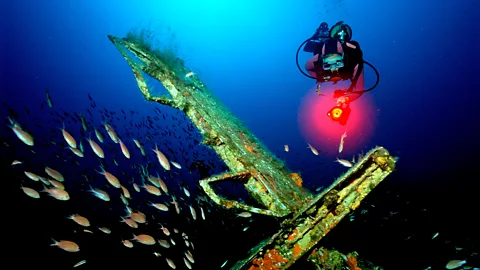 Getty images
Getty imagesAmong the 80-year-old sunken D-Day wrecks that line the coasts of Britain and France, wildlife is thriving on the wreckage of war.
Stretching for miles along England's Devonshire coast, between the sea and a patchwork of hills, lies the shingly expanse of Slapton Sands. Humpback whales can occasionally be spotted offshore. A thatched pub at the far end sells fish and chips in an oak-beamed bar. And each year, at dawn on 27 April, hundreds of dead soldiers rise up out of the waves and march across the fields. Or so goes a local ghost-story.
The tale has its roots in tragedy. In the spring of 1944, the coastline had become a training area for American troops. Their mission was to complete a secret, full-scale practice of the upcoming D-Day invasion of Utah Beach in Nazi-occupied France – part of an operation in which 160,000 Allied troops landed along 50-miles (80km) Normandy coast. But disaster struck when German E-boats snuck among the flotilla, torpedoing the gasoline-loaded ships, and leaving scenes of burning carnage in their wake.
More than 700 Americans died in the ensuing chaos: one of the largest single-incident losses for the US after the bombing of Pearl Harbour. The figure is much higher than the death toll for the eventual assault on Utah. Across all the landings on D-Day, an estimated 4,400 allied troops and thousands more Germans were lost.
Today, visual reminders of both the D-Day landings and its preparatory exercises are few and far between. Yet beneath the waves, tanks still litter the seafloor – alongside ships, landing craft, planes and an artificial harbour. And it is among these 80-year-old wrecks that an even more intriguing tale of life-after-death can be found.
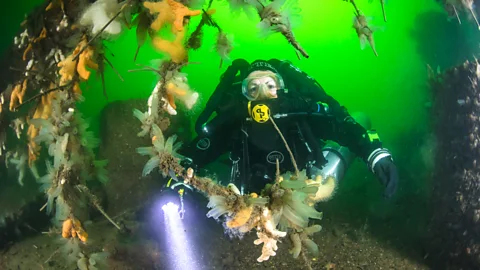 Marcus Blatchford
Marcus BlatchfordSteve Mortimer is a diver who specialises in identifying wrecks around UK waters. "Wrecks are a time-capsule underwater. They're very moving: the final resting place of people who fought for our country," he says.
On wrecks from World War Two, you may at first spot the paraphernalia, Mortimer notes: guns, degraded ships and even – on the Leopoldville, which sank off Cherbourg in 1944 – the helmets of GI soldiers. But then, he adds, you start to notice that these man-made relics are not alone.
"Gigantic" mushroom-like sea anemones, as big as your fist, cover ships in their hundreds and trap plankton in their feathery tendrils. Starfish cling to hulls. Fish, which would normally use natural reefs for cover, take up residence: pollock, ling, conger eels and sea bass, among others.
"It is fascinating to see nature reclaim things that were once a scene of disaster and tragedy, and bring them back into the fold."
 Marcus Blatchford
Marcus BlatchfordAccording to historian Harry Bennett, associate professor at the University of Plymouth, the Normandy invasion (and its build-up) contributed numerous examples of these artificial reefs to the English Channel.
When the flotilla set off from the UK on 5 June 1944, weather conditions were so bad that numerous landing craft and tanks succumbed. The following day, on D-Day itself, "swimming tanks" – amphibious Duplex Drive tanks that came with canvas floatation devices – and aircraft were sunk, as well as the Norwegian destroyer, HNoMS Svenner. On Ohama Beach in particular, only a handful of tanks made it ashore. By 21 June, more than 40 allied vessels in the region had been sunk or damaged by German mines.
Once these objects hit the seafloor, however, a new story began, Bennett explains. "When these tanks go to the bottom, they sit proudly, forming a home for smaller creatures and plants to colonise." The wrecks become "a silver lining to a sad story".
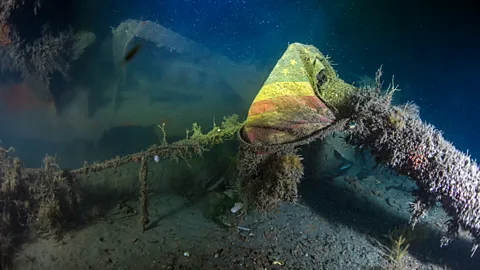 Marcus Blatchford
Marcus BlatchfordShipwrecks are not only of interest to divers and archaeologists; they are vessels for new life. And biologists are turning their attention to the estimated three million that exist worldwide. (Read more from BBC Future about the undiscovered shipwrecks waiting to be found.)
Trawlers avoid wrecks to save their nets. New species move in. And historic machines start to form mini, island-like marine parks for wildlife – becoming home to much more life than meets the naked eye, with research suggesting that microbiome "richness and diversity increase" in their vicinity. In a 2014 paper looking at wrecks off Australia's Great Barrier Reef, Thomas Stieglitz, an adjunct professor at James Cook University, even observed the biological influence of wrecks extending many metres from the original wreck site.
As well as providing "oases" for wildlife, says Rachel Priest, a PhD student and research assistant at Newcastle University's Dove Marine Laboratory, wrecks can help protect stocks of blue carbon: the carbon dioxide captured by ocean and coastal processes. By sitting on seabed sediment, wrecks stop the currents from washing it away, and as species live and die on these artificial reefs, they also replenish the carbon-sequestering sediment underneath, she explains
As the world's array of offshore energy infrastructure ages, shipwrecks could act as proxies for studying the long-term effect of rigs and wind farms, Priest suggests.
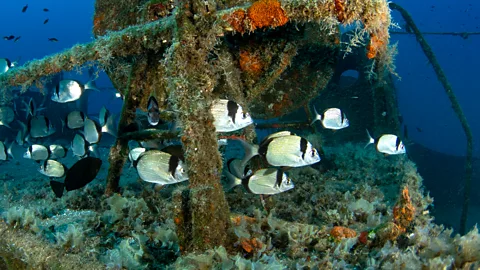 Getty
GettyStudying these changes could also be helpful in mapping the impact of climate change on coastal biology. Off the coast of Whitsand Bay in Cornwall lies the wreck of HMS Scylla: a former Royal Navy frigate that was deliberately sunk in 2004 for diving and research.
Already, Scylla has allowed researchers to observe changes in flora and fauna over time: from an initial flourish of barnacles, tubeworms, urchins, scallops and starfish, to the arrival of the plumose anemone Metridium senile, characteristic of wrecks, and a soft coral species, evocatively named "dead man's fingers". By 2007, brightly coloured wrasse fish colonised the reef, as had the pink sea fans common to south Devon and Cornwall. By 2009, 263 different organisms had made the Scylla their home.
A "Virtual Scylla" 3D model has even been developed around the wreck which includes a climate change game for use in schools. During the game, users must choose which temperature changes to deploy and which species to promote, from starfish to sea-urchin and barnacles.
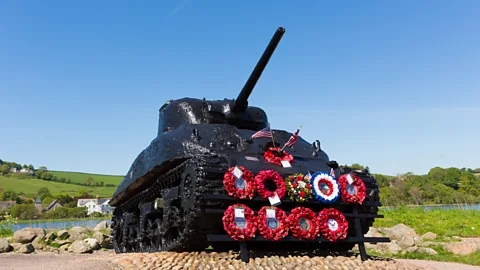 Getty Images
Getty ImagesArtificial reefs cannot entirely mimic their natural counterparts, however. And there are also unwanted consequences to man-made ocean debris. When wrecks land, they can alter or destroy existing reefs and vegetation. They can encourage invasive species, especially those which may be transported in ship's ballast water. Plus there is debate over whether artificial reefs simply draw fish from surrounding habits or result in new fish biomass.
Toxic substances on shipwrecks can also do substantial damage to marine life. Wrecks around the world are estimated to contain as much as 20.4 million tonnes (6 billion gallons) of oil – over 500 times more than was released in the Exxon Valdez oil spill. And even paint can be hazardous, with the Scylla's only showing colonisation where the tributyltin (TBT) antifouling paint has flaked-off.
More like this:
• The deep ocean photographer that captured a living fossil
Eighty years on from D-Day, the wreckage of war is still a powerful draw for both human visitors and marine wildlife alike.
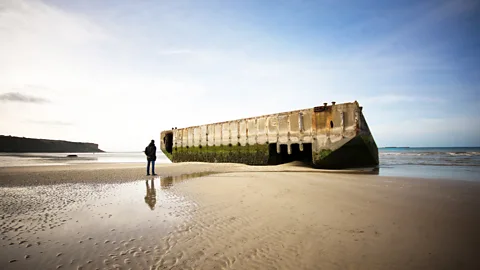 Getty Images
Getty ImagesAbove ground, back in the carpark at Slapton, visitors come to see the dredged remains of a large Sherman tank. Its hulking carcass is a rare reminder of the area's lesser-known history. Across the Channel in France, the concrete ruins of a Mulberry Harbour – floating docks used to unload cargo during the landings – can be viewed lying, like vast stranded dinosaurs, at Gold Beach in Arromanches-les-Bains.
"When you go down, you share the space with people who worked on the boat, survived on the boat and passed away on it," says Priest. And then, as nature moves in, you can once again "see a wreck providing life".
Comments
Post a Comment